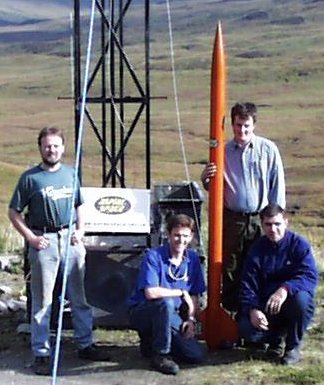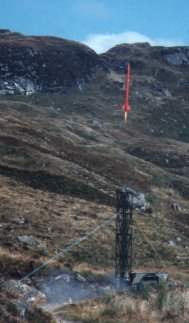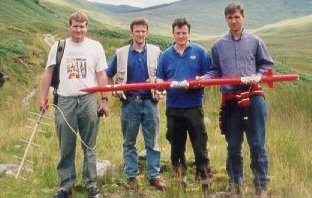

Aspirespace Rocket Engineering Society
ADV1
(Aspire Development Vehicle 1)
Following the launch of Aspire 1, the founder members of Aspirespace decided on the ambitious goal of launching a 10kg payload to an altitude of 100km in a reusable launch vehicle. This would be Aspire 2.
However, it was soon realised that it would be very difficult, if not impossible to make the giant leap from 3.5km to 100km, without a series of smaller rockets to test individual components, gather aerodynamic data and provide Aspirespace with experience of launching and recovering rocket vehicles. ADV1 was the first of these test rockets.
ADV1 had a hand-built glass fibre composite airframe, a hand-sewn parachute and was powered by a British made solid rocket motor with approximately 1250 Ns total impulse. The payload consisted of avionics for measuring the flight characteristics (including a full motion CCD video camera) and a telemetry system for obtaining the data on the ground while the rocket was in-flight.
Unfortunately, ADV1 was destroyed at an altitude of approximately 50 metres due to an overpressure in the combustion chamber. The avionics, CCD video camera and the motor section of the airframe were completely destroyed. However, two sections of the airframe and the recovery system were salvaged and some components have since been re-used on other Aspirespace rocket vehicles.

ADV2's
Aspire Development vehicle 2a
ADV2a was fired up in the Highlands of Scotland, and used a flightweight H2 with a 1 litre paintball tank for its nitrous tank, giving a mid-range 'K' class motor.
The thrust was high thanks to an uprated engine design we'd tested weeks before.
It flew as if on rails up to 6000 feet where the onboard computer popped a small drogue parachute, and then the main chute was deployed at 1000 feet.
The computer recorded acceleration and barometric pressure during the flight, which was later used to back-calculate the hybrid thrust and the vehicle’s drag.


Aspire Development vehicle 2b
ADV2b is the same size and shape as ADV2a, but contains seven times more propellant, making it a mid-range 'M' class motor. The engine produces the same thrust as ADV2a, so ADV2b will use strap-on solid propellant boosters to loft the increased mass.
The fuselage and fins are made of carbon-fiber composite as the vehicle will exceed Mach 1.
When we launch ADV2b, simulation software predicts it’ll reach about 17,000 feet above the launch-pad if carrying a commercial aluminium nitrous tank; however, we're developing a lightweight Carbon/Kevlar composite nitrous tank with a thin tank liner. The expected altitude is then 24,000 feet simply because of the reduced mass. (Composite tanks leak without an inner impervious liner, and a liner is required because the composite is highly flammable if exposed to nitrous. Composite resin can also make nitrous unstable.)

Aspire Development vehicle 2c
ADV2c (nicknamed 'Rickrock') is an upper stage designed to be carried aloft on top of ADV2b.
It uses a custom 1 litre nitrous tank, and fibreglass fuselage tubing. It's powered by an H2 motor of mid-range 'K' class. Its high performance and light mass means that it should reach about 12,000 feet when fired just on its own. Rather daringly, Rickrock burns every last gram of propellant: there’s zero residual plastic left in the chamber.
When we launched Rickrock Mk1 up in the Highlands of Scotland, we didn't know that a valve had frozen open which leaked a lot of nitrous out of the run tank before takeoff, which reduced the tank pressure. It rose ponderously off its launcher and disappeared over the horizon on a low, flat trajectory. Luckily, we got the top half of it back, because we’d fitted it with a homing device that transmitted on the HAM radio FM band. The flight computer was in this top half and recorded a respectable altitude of 8000 feet despite the propellant loss.
The bottom half including the hobbled engine tore away from the ‘chutes and is still up there in the heather somewhere.
A video of the launch can be seen here (double-click on the icon):
Rickrock engines 2 and 3 have now been completed; we’ve managed to shave 20% off the mass of Rickrock Mk1. We plan to launch Rickrock Mk2 soon.


ADV3
ADV3 will be the upper stage of Aspire 2 and will be used to thoroughly test all of the systems for use in the latter vehicle. It will be powered by a LOX/HDPE hybrid engine similar in size to the H20, but using composite materials for the LOX tank and combustion chamber. The Total Impulse of the motor will be approximately 25700 Newton-seconds, making it a lower-range 'O' class motor in High Powered Rocketry parlance.
Research and development of the composite LOX tank began at Delft University in Holland, and now continues in-house.
Fired just on its own, we estimate that ADV3 will reach an altitude of 25 km (82,000 feet), confirming Aspirespace as the leading amateur rocketry group in the United Kingdom.
Further details on ADV3 will be made available once the design of this vehicle has been completed.







